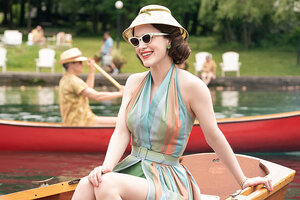Painting with fabric: The 'Marvelous' costumes that bring to life '50s New York

Rachel Brosnahan stars as Miriam 'Midge' Maisel in 'The Marvelous Mrs. Maisel,' an Emmy-winning TV show from Amazon. The second season debuts Dec. 5 and features costume design from Donna Zakowska, who uses color to convey 1950s New York to viewers.
Courtesy of Amazon Studios
Before she designed costumes for the TV show “The Marvelous Mrs. Maisel,” Donna Zakowska studied painting. And that’s what she feels, in a way, she’s still doing today.
“It’s really like painting with fabric,” Ms. Zakowska says. “That’s the way I see it, basically.”
Zakowska is the force behind the big-skirted dresses, natty hats, and beatnik styles of the Emmy-winning “Maisel” from Amazon Studios, which returns for its second season on Wednesday. She puts her mark on the comedy-drama, set in 1950s New York, through the uninhibited use of color and the places from which she draws inspiration – including photographs from the era.
Why We Wrote This
Perhaps not since Kay Thompson urged fashionistas to “Think Pink” in the musical “Funny Face” have 1950s fashions popped from the screen as vibrantly as in “The Marvelous Mrs. Maisel.” That sartorial verve comes from Emmy-winner Donna Zakowska, a trained artist who now uses fabric as her medium.
“It’s one of the most beautiful shows I’ve ever seen on television in terms of costume,” says Ellen McCartney, director of design and production and head of costume design at the California Institute of the Arts in Santa Clarita. “It’s [Donna’s] point of view and it’s beautiful. It helps you see the period in a way that you might not just looking at research on your own.”
Chief among Zakowska’s responsibilities is outfitting Rachel Brosnahan, who stars as Miriam “Midge” Maisel, a housewife who turns to stand-up comedy after her husband leaves her. Beyond Midge’s wardrobe (which fans are eager to copy), dapper apparel is also needed for the men in her life, like her father Abe Weissman, played by Emmy winner Tony Shalhoub of “Monk” fame. But before Zakowska and her team of about 20 people pick up needle and thread, she does plenty of research – something she’s experienced at after working on Revolutionary War-era shows such as HBO’s “John Adams,” for which she won an Emmy, and AMC’s “TURN: Washington’s Spies.”
As with many artists, Zakowska’s decisions are often driven by color, she explains in a phone interview. “My whole life was really about painting and color,” she says of her studies before costume design, which included time at Paris’s École des Beaux-Arts and Barnard College in New York. “And then I went to Yale [School of Drama] and got into design. But it’s really a little bit about instinct. I have very, very strong feelings and reactions to color. So it just either feels right or it doesn’t.”
She is not very fond of pink, for example. But that hasn’t stopped her from outfitting Midge in it – or sorting through hundreds of swatches to find just the right shade. The color, Zakowska says, reflects both the time period in which Midge is living and how Midge starts the series – in “rose-colored glasses” – complacent and seemingly leading a perfect life as a wife and mother. Until, that is, her husband tells her he’s having an affair and is leaving her.
“I never really chose pink to do things because sometimes it denoted a sort of female image that I didn’t really like,” she explains. “Then it became the iconic color for her and I’ve really come to appreciate pink.”
Ms. McCartney, who once worked with Zakowska years ago for a couple of days, notes that people respond emotionally to color. Costume designers, “compose a visual image that can be read whether there’s language or not,” she says.
Zakowska collaborates with series creator and director Amy Sherman-Palladino, who also created “Gilmore Girls,” and Ms. Brosnahan. She consulted with Ms. Sherman-Palladino when she chose a red dress for the scene when Midge’s husband, Joel (Michael Zegen), tries to persuade Midge to make their marriage work. “I wanted, when he came back, for her to be stronger than strong, you know what I mean?” she says. “And that’s the sort of thing where I talk to Amy about it and then it will appear in the script.”
When it comes to creating other looks for Midge and the people in her world, inspiration can sometimes come from an accessory. “I might pull a color out of the shoe and say, well, let’s do that,” Zakowska says. She cites New York photographer Saul Leiter, whose first exhibition of color photography was in the 1950s, as an influence. “One photograph … could really trigger a whole outfit,” she says of his work.
Zakowska, who often creates the costumes from scratch, thinks these period looks are garnering interest because they are wearable. “I mean, I loved ‘John Adams’ … and I got an Emmy for that and everything, but no one really imagined themselves in the clothes in the same way.”
“Maisel,” rated TV-MA for profanity and nudity, won multiple Emmys this fall, including for best comedy series and for lead actress in a comedy series. The team of Zakowska, Marina Reti, Ginnie Patton, and Sheila Grover was nominated for best period costumes.
For Zakowska, the ultimate consideration for all the clothing is the scene and what’s happening with the character.
“You’re telling a story,” she says. “Clothes tell a story.”

